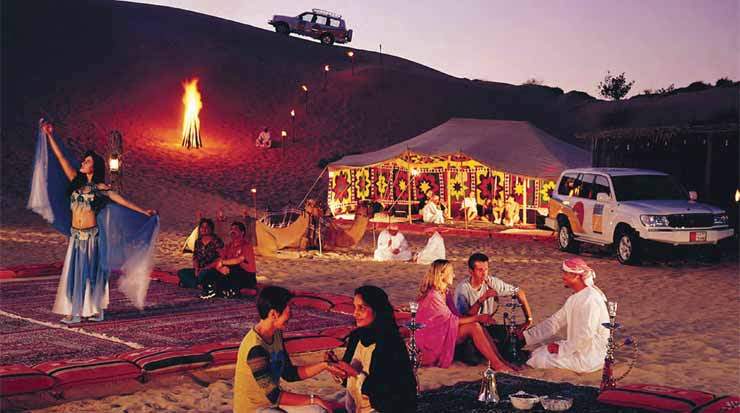As Ulrike Andorff, general manager, BurJuman Arjaan by Rotana, noted, over the past years, demand has been developing in tandem with the destination’s offering.
“Dubai has been planning and responding to the increase of visitors proactively by improving infrastructure by building new roads, bridges, extending the airport and the metro.
Besides the increase of new top luxury hotels, the hospitality industry has also extended its portfolio with a number of four- and three-star hotels to attract a diverse clientele [by] making the destination more affordable,” explained Andorff, saying that apart from a varied hotel portfolio, the emirate has also enhanced its leisure offerings with appealing projects, such as Dubai Parks & Resorts, IMG World of Adventure or Bluewaters Island with the much anticipated Ferris wheel being its highlight.
“As these attractions aim at the mass market, midmarket hotels are set to benefit,” suggested Andorff.
In recent years, Dubai has indeed deliberately swung away from its well-established profile of strictly high-end hotels and spectacular but often pricey attractions to appeal to a broader audience.
“I believe that the development of Dubai’s tourism sector has by now ensured that we also cater for the midmarket segment; the younger generation that wants to explore the destination and is looking for a good quality product but not necessarily a high-end offering,” supported Michael Kuhn, general manager, Park Inn by Rezidor Hotel Apartments, Dubai.
This view was reiterated by Saleem Mogral, general manager, Al Majid Travel & Tourism Dubai, who elaborated on the emirate’s transformation into a year-round value for money destination, which appeals to a wide spectrum of travellers from economy tourists to elite globetrotters.
In fact, in recent years the emirate, which was previously saturated with luxury properties, has witnessed the emergence of a myriad of midscale establishments on its horizon, in line with its long-term targets and its core multi-source visitation strategy.
“We have seen in the past few years, and will continue to see in the coming years, a surge in three- and four-star hotels being built and managed by reputed international chains,” said Wehbe, arguing that the shift towards such addresses would dilute the quality.
“It is not that Dubai is going cheap or offers economy stays but that there are different types of clients and they would like to have the choice to stay in five, four or even three-star hotels,” said Wehbe.
Yet, as Butt noted, the stiffening competition should be taken as a challenge and opportunity to further improve service levels and high standards rather than an excuse to lower the values.
Likewise, Frida Audi, director of business development, Habtoor Grand Resort, Autograph Collection, a Marriott Luxury Lifestyle Hotel, touched upon the significance of personalisation as a crucial factor, saying that guests should be well taken care of from the moment they land in the emirate up until their departure.
As a matter of fact, focussing on the constant delivery of quality services to ensure guests’ many return to Dubai is mandatory to all hoteliers, stressed Andorff.
“Assessment of [guests’] changing geographical origin is obligatory in order to cater to the requirements of a varied clientele. Hoteliers need to stay updated on the happenings to promote not only the hotel but the destination as well,” underlined Andorff.
Along parallel lines, Pierre Sokhon, general manager, hospitality division, Al Khoory Hotels, said, “To be able to exist and survive in Dubai, quality always [has to be] the priority whether it is a one-star or a five-star hotel.”
In order to maintain impeccable standards, Sokhon called for the establishment of more hotel management institutions to ensure qualified staff in the long run.
Quality has never been a concern and as Padhi reminded, governmental departments have long played a great emphasis on maintaining service levels and ensuring customer rights. Remarkably even a happiness minister has been appointed to enhance the wellbeing of residents and visitors alike.
As Samir Arora, general manager, Hawthorn Suites by Wyndam Dubai, JBR, also noted, Dubai already set out high hotel classification standards, ensuring the destination’s favourable perception.
To remain competitive, hoteliers are also boosting their offering in terms of food and beverage, bundle packages as well as freebies.
All these come amid increasing competition, which, as Arora noted, still allowed the hotel to achieve a year-on-year improvement in occupancy, however, average daily rate remained flat due to the emirate’s expanding room inventory.
In fact, according to HotStats, in the first half of the year all three key performance metrics, including occupancy, average room rate and RevPAR showed notable declines, leading to a drop of 13 percent in gross operation profit per available room.
As Badawy pinpointed, Dubai’s current room inventory stands at around 100,000 keys and by 2020, this number is set to soar to 120,000 which, as he said, should be sufficient for the anticipated 20 million visitors per annum.
Yet, industry stakeholders show little sign of concern about supply outpacing demand growth with Sokhon stating that with current developments and the upcoming launch of crowd-pulling attractions, including theme parks, the recently-unveiled Dubai Opera as well as adventure activities, along with an array of conventions and shopping festivals throughout the year, the destination is laying the foundations for long-term success.
Further elevating Dubai’s position on the global tourism map, the much-anticipated Dubai Opera has recently held its opening night, offering world-class entertainment with almost 75 shows already announced, and according to Jasper Hope, CEO, Dubai Opera, the number is expected to rise to 200-250 performances per annum with various forms of arts from opera to jazz and Broadway and West End hits all coming to Dubai.
In the same context, Philip Jones, general manager, Mövenpick Hotel Jumeirah Beach, cited Dubai’s consistent track record of generating year-on-year increase in arrivals.
“The reason for this are manifold, however, the two main driving factors are the significant growth in reach of Emirates airline and its ability to handle more inbound passengers to Dubai.
This, together with the increase in the hotel inventory to meet the ever-growing number of visitors has been the perfect model for success,” elaborated Jones, saying that despite the resourceful investments, there is still room for growth not only due to the aforementioned facts, but also due to the scale of upcoming projects coupled with infrastructure enhancements, including the emirate’s new hub, Dubai World Central (DWC), which upon completion will boast a capacity of more than 160 million annual passengers, becoming the world’s largest airport.









